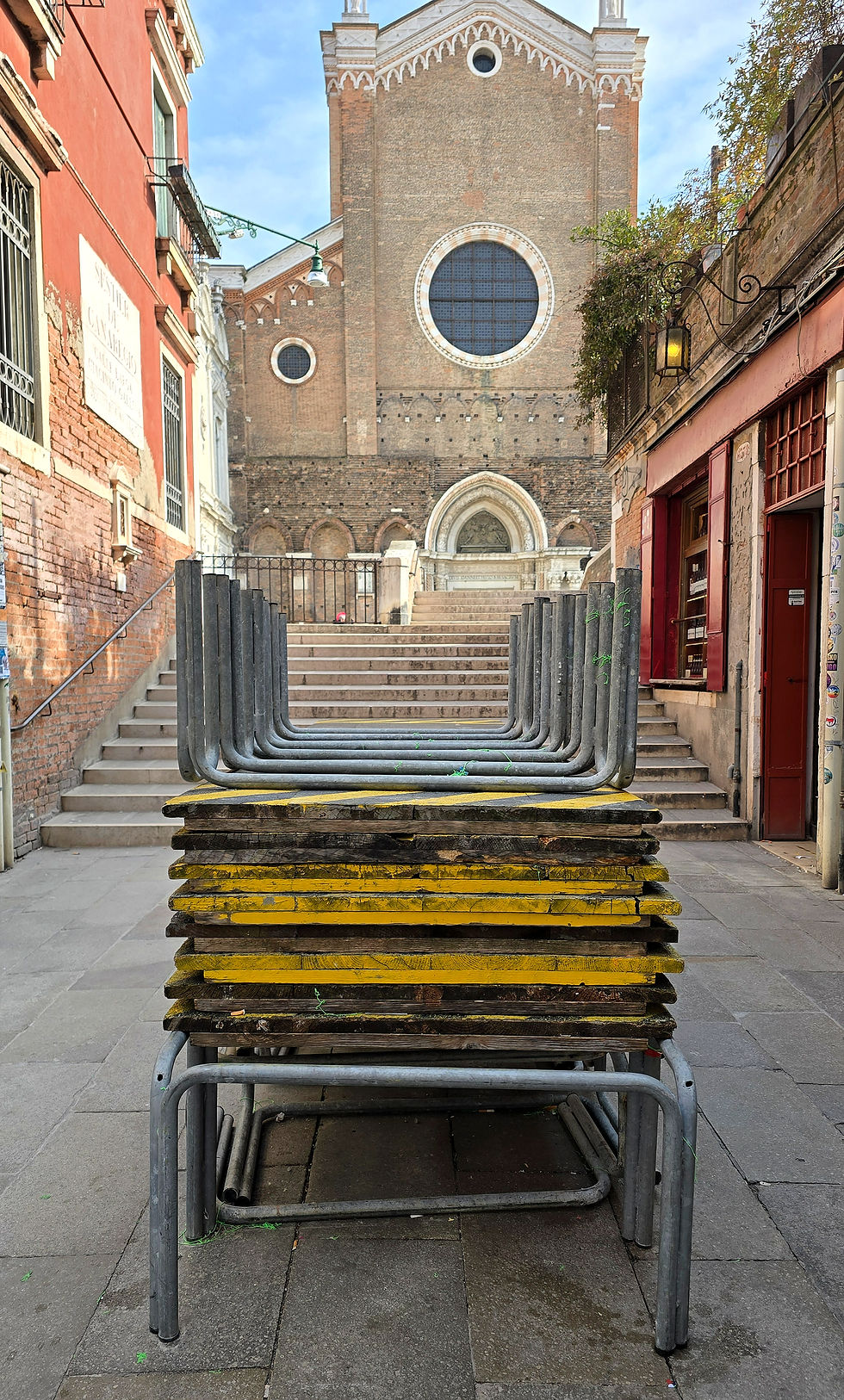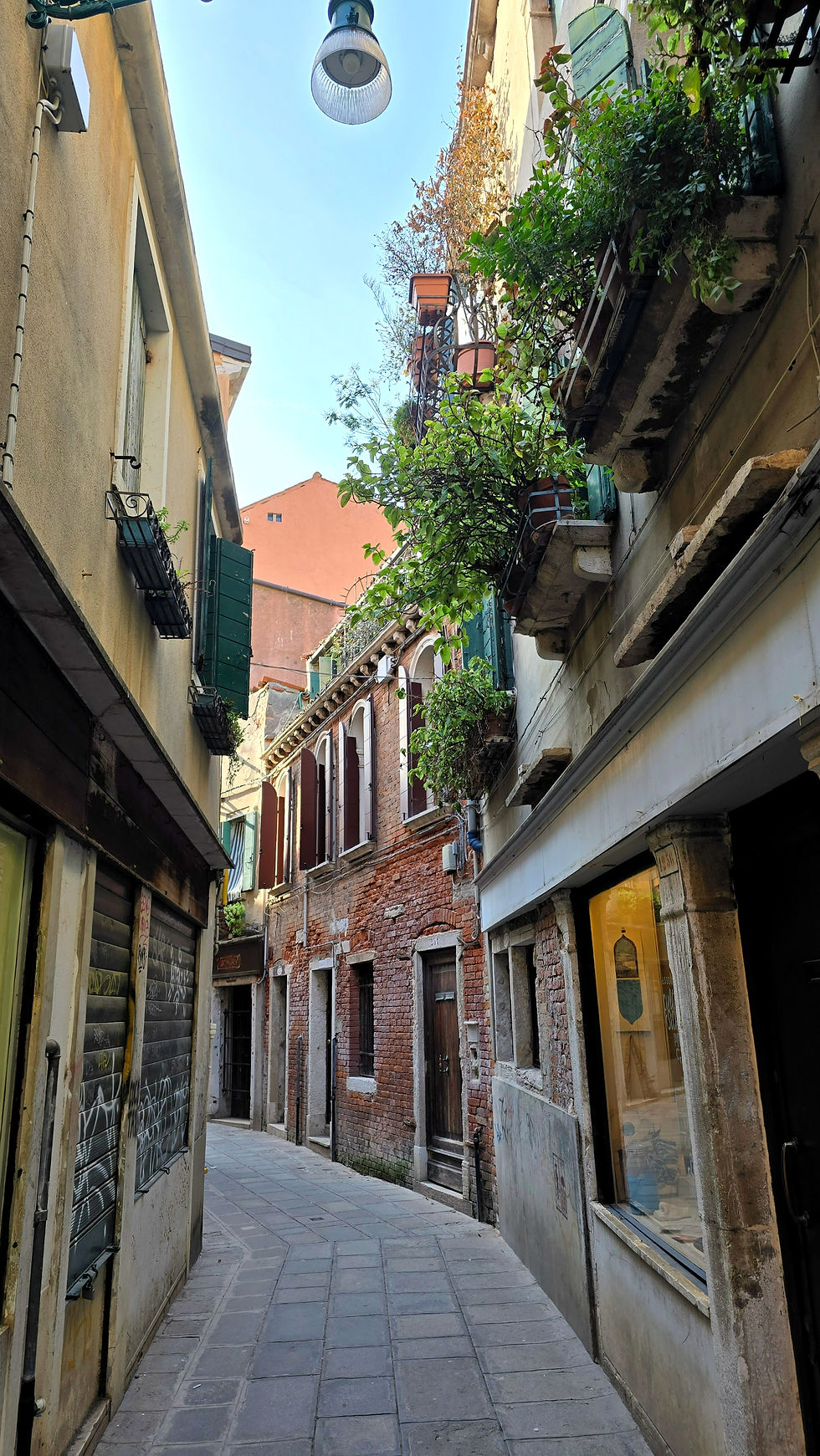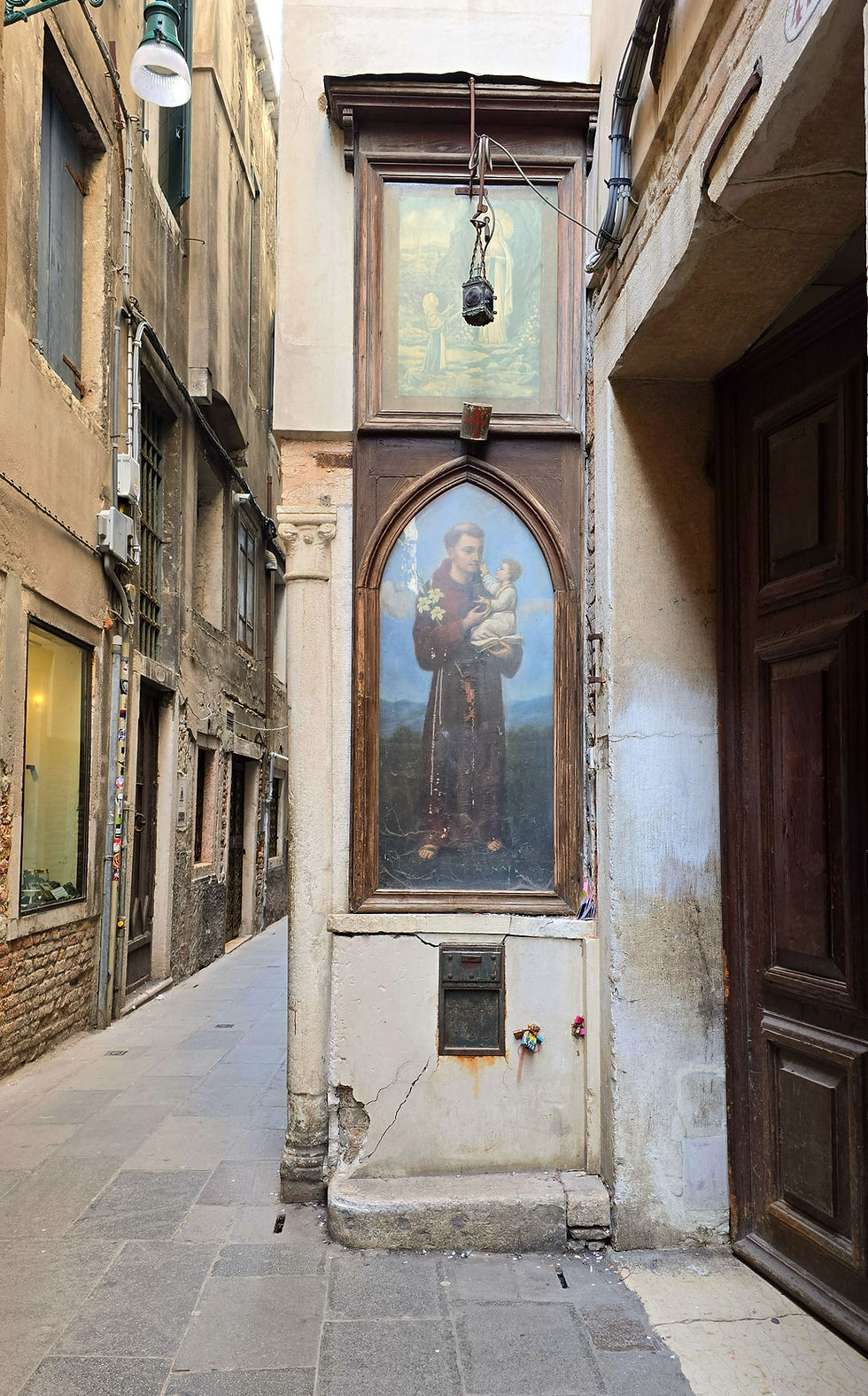The Detourism of Venice - How to Save a City From Drowning, in Tourists
- Mangia Mangia
- Apr 4
- 9 min read
Updated: Apr 5
Venice celebrated its 1604th birthday last week but never have the Venetians felt less inclined to send out their party invitations.

As a protected UNESCO site, Italy's spectacular city built on water becomes more fragile every day. Besides rising tides and sinking buildings, Venice has been under watchful eyes due to the negative impacts of mass tourism. And yet again, questions are asked whether it belongs on the 'Endangered Heritage Site' list.
In 2014, UNESCO warned the Italian government that Venice needed relief with a 2-year deadline to put measures into place. Controversial crowd control was introduced by Mayor Luigi Brugnaro, things like turnstiles and traffic segregation, all criticised by locals as violations of the city's character. In an ongoing rollercoaster of unpopular risk assessments, once again, in 2021, Venice narrowly missed making the 'Endangered List' only to be voted off, and then back on again in July 2023. UNESCO stated: "The effects of the continuing deterioration due to human intervention, including continuing development, the impacts of climate change and mass tourism threaten to cause irreversible changes to the outstanding universal value of the property,"
Escaping the dreaded list through the implementation of two systems: il Mose anti-flooding barriers and a recently introduced tourist tax, Italian Culture Minister, Gennaro Sangiuliano remains adamant the city is not actually at risk.

The Mose Barriers
Activated for the first time in 2020 as an enormous undertaking by the Ministry of Infrastructure spanning 20 years and costing 5.5 billion euros, rows of gates on the lagoon bed were built to be lifted at imminent high tides, separating the lagoon from the Adriatic Sea. The gates aim to protect against subsidence and erosion threatened by high waters. Four main barriers are positioned between Lido, Malamocco and Chioggia with an estimated cost of 50 000 euro to lift each one at a sea level rise of 120cm. In 2023, they were lifted 32 times. Now, the level has been reduced to 110cm. MOSE is named after the first experimental gate, Modulo Sperimentale Elettromeccanico, but has a significant double meaning as the Biblical man who managed to part the rising waters; Moses.

Tourist Tax
In 2024, Venice introduced a tax of 5 euros per day-visitor after piloting the scheme. Officials were ordered to carry out spot checks requesting proof of payment by the masses after turnstile gates were dramatically rejected by the people of Venice. "We're not a theme park" they'd said. But In the space of 11 days, the city had pocketed 1 million euros according to Euronews, money to be cleverly invested in a city in need of relief.
However, this was never about money, it was simply about crowd control.
So, did it work?
Venice's tourism office claims the fee encouraged early-bird bookings but didn't fix the mass tourism issues. In further attempts to quell the crowds, 2025 will see 'tourist tax' double to 10 euros for last minute bookings made within 3 days of visiting, tourist groups of over 25 people are now banned along with loud speakers, picnicking, swimming in the canals, wearing swimming costumes and even dragging loud luggage along the streets, but it seems not much is working. Only recently, February's carnival celebrations were attended by 60,000 spectators according to Il Nord Est, cramming Rialto Bridge in a crush that took social media by storm. 'Don't come to Venice amore!' was the slogan in TikToks and Instagram reels of the drowning crowds. Carnival and Easter fall outside the tourist tax range which currently begins after Easter and lasts until the end of July.

Last month, while touring for my book Appetito, I found calm and serenity by drifting through the tiniest calli and lesser-trodden tracks. Venice is a city of Venetians where children kick a football in a campo on a dusty afternoon. Washing lines shift in the breeze and some spaces are completely empty. As someone who steers away from crowds, I love to ditch the map and take the quirky streets, especially here, and I believe our children have also learnt to travel this way. The joy in finding an authentic spot where thick dialect is spoken, menus are scribbled on chalk boards and wine is handed out in tumblers, brings me a secret sense of accomplishment like finding a bargain in a thrift shop. I don't want to be pressed in a throng to wait to see a view, I don't want to choose Roman carbonara or spaghetti alla Bolognese from a laminated tourist menu in another region completely where local ingredients are prepared with immense pride. To step aside is to seek out authenticity in local markets, rustic osterie and bacari.
Italy is as beautiful as the food is varied. 'Eat regional' reigns supreme and rings true in every village and city. Venice's lagoon foods are fresh and vibrant and packed with history and legend, just like every local plate in Italy has a story to tell, just like every ingredient has. Lose your map, discover San Marco's Secrets, visit in Winter and experience ancient bacari in this city that is truly unique. In doing so, you combat a wave of mass-tourism that is rapidly depleting the soul of our favourite destinations.

The Effects of Mass Tourism
"What's a bit of a crowd?" you may ask.
The World Tourism Organisation (UNWTO) defines Over Tourism as: 'the impact of tourism that excessively and negatively affects the perceived quality of life of residents and the quality of visitor experiences'.
According to roadgenius.com, Venice welcomes up to 60 000 visitors a day into a city of under 50 000 inhabitants. The effects of erosion on canal infrastructure and heritage sites become a factor, along with water and air pollution due to extra traffic along the canals and waste management that is progressively harder to control but a consequence none of us visitors notice is a subtle one, something that makes residents sadder every day. Venice is losing its character.
As locals leave, houses are converted into hotels and traditions leave with them. Venice has an unmistakeable dialect spoken between generations of proud Venetians. You'll hear it in artisan shops or between gondoliers. Foods like cicchetti and squid ink risotto are typically 'alla veneziana' and traditions like 'la Festa del Redentore', a 400 year old boat and fireworks party in July, are classically theirs. Venice turned 1604 last week but with a decline from 174 000 local residents in the 1950s to less than a third of that number now, it seems the beauty of a quirky, arty, laid-back character is quickly being diluted. Just look at the dropping live counter on Venessia.com's site to see how many residents are left, in real time.
"Venezia non e Disneyland" is what the Venetians say, Venice is not Disneyland.
The first time my father visited Venice, he flew in via Concorde to join a cruise from Istanbul to Barcelona. The route went via the Canal Grande, the ship was The Grand Princess. In 1998, she was the largest cruise ship in the world at 107 000 tonnes and not a thought about eco tourism. As excited passengers gathered on her 40m wide decks, an announcement cheerfully broke the loudspeaker, "Ladies and Gentlemen, welcome aboard the Grand Princess. We are delighted to be cruising through Venice's Grand Canal where in certain places, there'll be less than 1 metre below ship."
4 years ago, cruise ships over 55 000 tonnes were banned from entering Venice's canals, they now skirt the outside of the island and dock on the mainland.

Overtourism is a term used frequently in cities like Dubrovnik, Amsterdam and Barcelona where anti tourism protests erupt all the time.. It's something you see more and more in Venice too, #EnjoyRespectVenezia and #Detourism are two municipal campaigns to combat this. These initiatives by the Commune di Venezia present a wider and more authentic offering of the city's sights, things like walking tours instead of gondola rides, historic gardens, parks and churches or culinary experiences off the beaten track.
"Detourism is the City of Venice's awareness and information campaign to promote sustainable tourism presenting a different Venice. It suggests authentic experiences, out-of-the-ordinary places and itineraries not only in the city centre of Venice, but also on the lagoon islands and mainland."
Encouraging you to 'take a detour' and become a 'detourist' through a free newsletter on sustainable tourism and online magazines, you'll discover a range of genuine aspects and events showcasing the true character of Venice. See the end of my post for more content and websites to explore.

I interviewed Diego Porceddu, founder of social media account LoVenezia - a community of over 35 000 followers dedicated to inspiring love and respect for Venice. I wanted to dig deeper into true local, feelings surrounding tourists and what Venetians believe we can do to help.
(Translated from Italian)
"My story with Venice began in 2011 when I visited for the first time. It was love at first sight. It's not only a city, it's a refuge, a limitless source of inspiration. Over recent years, I've seen Venice change deeply, a little like our society has changed. Many artisan shops and local stores, which portrayed the true soul of the city, have shut their shop blinds. In their place have arrived franchises, identical in all cities of the world, or poor-quality souvenir stores that have little to do with Venetian traditions."
"There's another change that impacts the uncontrollable growth of hospitality businesses. Apartments, entire buildings, even spaces historically dedicated to homes or students, have been converted into tourist accommodation. This has taken away spaces from those who live here every day. It's almost as if the city itself has become a shop window."
I asked Diego how tourists are 'seen' in Venice. "The relationship between tourists and Venetians is incredibly complex", he said, "I'd define it as a union of love and hate. Venice is a city that equally survives thanks to tourism, it is loved and desired by people all over the world - and it is wonderful to see the fascination.. But, at the same time, in recent years, this love has transformed into something that is too exhausting to sustain. When a city loses its people to make space just for those who are passing through, it's natural that a sense of frustration comes about. Thus, often, the tourist is inadvertently seen not as a guest, but as someone who is depleting the soul of the city."
"I don't want to generalise", states Diego, "There are many visitors who come with respect, curiosity and sincere love for Venice. But then, there's also a kind of 'hit and run' tourism that consumes without comprehension, that leaves behind litter, noise and destruction."
"Venice is fragile, and needs care. We should look after her more, limit the excess, educate those who visit and punish those who injure. This way, and only this way, will she continue to bring magic not just to her visitors, but, above all, to her inhabitants."
"Every day at LoVenezia, we work to put forward an authentic Venice, less polished and more 'lived in', highlighting her most genuine attributes. We give a voice to those who are deeply connected to the city and create a synergy through small, local businesses that represent the pulsing soul of the territory. In our small way, LoVenezia seeks to contrast the negative effects of mass tourism, proposing a different way to experience and visit the city: slower, more respectful and more conscious. We want to help raise an awareness that Venice is not just Carnival and big events: it's alive and deserves to be discovered all year round and in every season, even in her most silent moments."
Diego believes the most important thing a tourist can do protect Venice is to truly love and respect the city. This means adopting certain simple behaviours that are fundamental: "Don't litter, don't sit wherever you like and don't throw rubbish into the water, don't shout, don't treat the city like a playground."
"Venice is fragile, it is unique and it is home to many. Enter the city on tip-toes, with respect, as if you are entering a sacred space. And choose to visit with more serenity and calm, outside of the busiest seasons, this can make all the difference. Pause to discover the less-travelled areas, support the smallest shops, and eat in restaurants run by Venetians, all of this helps Venice remain alive and authentic."
"Protecting Venice means simply behaving as a conscious guest and not as a distracted consumer. If everybody makes even the smallest gesture with love, the city benefits enormously."

When I asked my Instagram followers if they'd visited Venice and found calm and quiet or enjoyed a beautiful, Venetian meal, all of them said 'yes'. This was heart-warming to read and I can only hope to have contributed inspiration in some way through my writings, cookbook and photography.
In a world where travel becomes more accessible every day, let's not take it for granted.
There's a brighter future for the enchanting city built on water, one with more respect.
We're raising our glasses to 1604 glorious years and to Venice's good health with many more birthdays to come. Cin cin beautiful city, here's to you.
If you'd like to find authenticity and/or read up on the preservation of Venice, here are a few dedicated websites:
And social media handles:
Comments